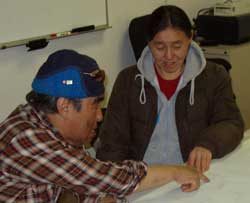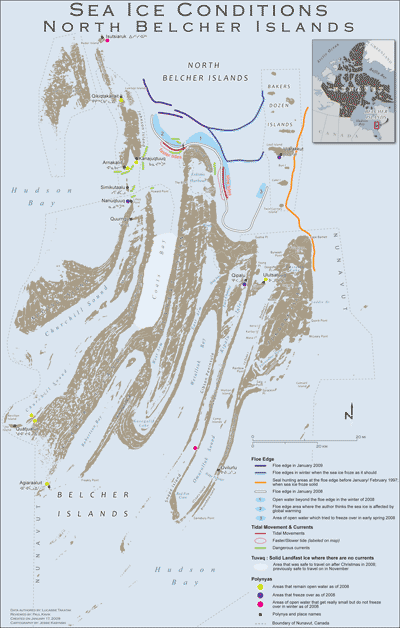Lucassie Takatak: Sea ice observations
Lucassie Takatak has spent decades traveling on the ice around the Belcher Islands, hunting for the Sanikiluaq community and teaching young hunters. Hunters have long relied on stable sea ice conditions to reach seals, geese, ducks, and whales. But sea ice extent and thickness have changed recently, causing Lucassie and other hunters to find new hunting routes to avoid dangerous ice.
Changes in sea ice extent and thickness
Interview videos: Part 1 - Part 2 - Part 3 - Part 4 - Part 5
Sanikiluaq hunter Lucassie Takatak discussed sea ice conditions in January 2009, when he was interviewed by Miriam Fleming, with translator Dinah Kavik. Video credit: Caroline Meeko, Jr.
When interviewed for the Sanikiluaq Sea Ice Project, Lucassie indicated that the ice floe edge, which once extended northeast beyond the Bakers Dozen Islands, has retreated south, and he has not been able to go seal hunting among the northern islands. When discussing the Bakers Dozen Islands, Lucassie said, “Before 2000 was when the ice used to be thick. It would start freezing in November and it froze. This used to be completely frozen over and not the least bit dangerous when we hunted seal there” he said. Typically, the ice is safe to travel on by late December, but during the past several years, the ice was too thin to be safe at all during the winter.
Even when traveling to other northern areas, such as Johnson Island, hunters cannot make as many winter hunting trips before the ice becomes too dangerous to travel on. And during springtime, when Lucassie hunts geese, certain hunting areas have become inaccessible because the ice no longer becomes thick enough.
Changes in sea ice conditions
In addition to changes in extent, Lucassie has observed changes in sea ice conditions. He said, “When sea ice froze it used to be black until it got older but now the ice freezes looking white but very thin because the salt water is not as cold as it used to be.” Lucassie also marked on his map where currents have changed along the new floe edges, which can affect the stability of the remaining sea ice.
In general, sea ice that has been dependable for generations has become unsafe. Lucassie recalls hunting with his late uncle, and noted one instance during which his uncle almost fell through ice that should have been safe. Even the generation before Lucassie’s was noticing changes in sea ice conditions that affected their hunting.
 Hunter Lucassie Takatak shared his sea ice observations as part of the Sanikiluaq Sea Ice Project. Photo credit: Miriam Fleming
Hunter Lucassie Takatak shared his sea ice observations as part of the Sanikiluaq Sea Ice Project. Photo credit: Miriam Fleming View a full-size map of Lucassie Takatak's sea ice observations, with a key to his notations and what they mean.
View a full-size map of Lucassie Takatak's sea ice observations, with a key to his notations and what they mean. View a full-size map of Lucassie Takatak's sea ice observations overlain on a Moderate Resolution Imaging Spectroradiometer (MODIS) satellite image.
View a full-size map of Lucassie Takatak's sea ice observations overlain on a Moderate Resolution Imaging Spectroradiometer (MODIS) satellite image.

